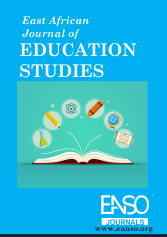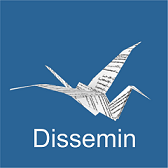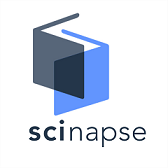Principal’s Teacher Working Environment Strategies on Teacher Performance in Public Secondary Schools in Mumias East Sub-County, Kenya
Abstract
Does the school principal’s strategy for a good working environment affect teacher performance? This study sought to answer the question by exploring the data from Mumias East Sub-County, Kakamega county, Kenya. A mixed methodology which entailed gathering quantitative and qualitative data on strategies of teacher working environment against each of the teacher performance aspects comprising of teacher lesson attendance, students mean scores and TPAD scores, was used. Also, A cross-sectional descriptive study design was adopted. To gather data, the instruments used comprised sampling of secondary data, individual in-person interviews for quality assurance officers, sub-county directors, and school principals, student questionnaires and teacher questionnaires. Collected data was then analysed using linear regression, averages, percentiles, and standard deviations. It was discovered that as earlier studies showed the impact of certain working conditions, like the school compound's lighting and facilities, on teacher performance, this research confirmed the impact of security aspects and workload management strategies on teacher performance. Additionally, from the data gathered, principals were implementing various strategies to improve the teacher’s working environment, and the extent of use of the various strategies affected teachers’ performance. For instance, it was discovered that there was a medium correlation between lesson attendance and recovery (adjusted R2 = 0.049135, at F = 0.001214, p = 0.001, and t = 38.31412), low correlation with the students' means scores (adjusted R2 =0.060101, at F = 0.000325, p = 0.001, and t = 10.86456) little correlation with TPAD scores (adjusted R2 = 0.041847, at F = 0.002887, p = 0.001, and t = 37.73538). After a comparison of data analysed using various instruments, the principals’ strategies for the working environment were established to affect teacher performance. The most affecting factors are highlighted in the summary and conclusions.
Downloads
References
Horvath, M. H. (2015). Essays on Student Sorting and the Value-Added of Teachers. University of California, Economics. Carlifonia: Berkeley CA. Retrieved June 10, 2021, from https://www.worldcat.org/title/essays-on-student-sorting-and-the-value-added-of-teachers/oclc/919404479&referer=brief_results
Indeed Editorial Team. (2021, March 29). Positive Working Environment: Definition and Characteristics. (I. E. Team, Editor, Indeed, Producer, & Indeed) Retrieved April 30, 2021, from Indeed Career guide: Career Developement: https://www.indeed.com/career-advice/career-development/positive-working-environment#:~:text = A%20positive%20working%20environment%20is%20a%20workplace%20that, safety%2C%20growth%20and%20goal%20attainment & text = Companies%20can%20achieve%20a%20positive, emplo
Lucky, E. B., & Chika, N. I. (2018, December). Working Environment and Teachers’ Productivity in Secondary Schools in Port-Harcourt Metropolis. International Journal of Innovative Psychology & Social Development, 6(4), 39-49. Retrieved December 02, 2022, from www.seahipaj.org
Merlo, A. (2022, February 19). How Teachers can Improve their Perfomance in the Classroom. Retrieved December 01, 2022, from Europass Teacher Academy: www.teacheracademy.eu/blog/improve-teacher-performance/
Odunga, E. W., Ogula, P., & Nganzi, C. A. (2020, December 30). Effects of Teacher Quality on Students’ Academic Achievement in Secondary Schools In Baringo North Sub-County, Kenya. Global Journal of Advanced Research, 7(4), 135-146. Retrieved April 30, 2021, from http://gjar.org/publishpaper/vol7issue5/D1034r69.pdf
Olowoselu, A., Mohamad, M., & Aboudahr, S. M. (2019, July 10). Path-Goal Theory and the Application in Educational Management and Leadership. Education Quarterly Reviews, 2(2). Retrieved December 14, 2022, from https://ssrn.com/abstract = 3415262
Sellen, P. (2016, October). Teacher workload and professional development in England’s secondary schools: insights from TALIS. Education Policy INstitute, Teacher supply and Quality. London: Education Policy INstitute. Retrieved May 30, 2020, from https://epi.org.uk/wp-content/uploads/2018/01/TeacherWorkload_EPI.pdf
Sudja, N., & Yuesti, A. (2017, September). The Influence of Education and Training, Leadership, Work Environment, Teacher Certification on Discipline and Teacher’s Professionalism in High Schools at Bali Province. Scientific Research Journal (SCIRJ), 5(9), 102-108. Retrieved April 30, 2021, from https://www.researchgate.net/profile/Anik-Yuesti/publication/321696338_The_Influences_of_Education_and_Training_Leadership_Work_Environment_Teacher_Certification_On_Discipline_and_Teacher%27s_Professionality_In_High_School_at_Bali_Province/links/5a2b51c0a
Teece, D. J. (2018, January 24). Dynamic capabilities as (workable) management systems theory. Journal of Management & Organization, 24(3), 359 - 368. doi:https://doi.org/10.1017/jmo.2017.75
Too, F. A. (2019, December 25). KCSE 2019 Results: Kakamega County top Schools. Retrieved June 17, 2020, from Teacher.co.ke: https://teacher.co.ke/kcse-2019-results-kakamega-county-top-schools/
Tropova, A., Myrberg, E., & Johansson, S. (2020, January 08). Teacher job satisfaction: the importance of school working conditions and teacher characteristics. Educational Review, 73, 2021(1), 71- 97. doi:https://doi.org/10.1080/00131911.2019.1705247
UNICEF and the African Union Commission. (2021). Transforming education in africa: an evidence-based overview and recommendations for long-term improvements. unicef.org. Retrieved Dcember 03, 2022, from https://www.unicef.org/media/106686/file/Transforming%20Education%20in%20Africa.pdf
Wahyudi. (2018, April). The Influence of Emotional Intelligence, Competence and Work Environment on Teacher Performance of Smp Kemala Bhayangkari Jakarta. Scientific Journal of Reflection: Economic, Accounting, Management and Bussines, 1(2), 211-220. Retrieved April 30, 2021, from https://ojspustek.org/index.php/SJR/article/view/139/136
Walker, M., Worth, J., & Brande, J. V. (2019). Teacher workload survey 2019. Government Social Research, Education. New York: National Foundation for Educational Research. Retrieved May 30, 2020, from https://assets.publishing.service.gov.uk/government/uploads/system/uploads/attachment_data/file/855933/teacher_workload_survey_2019_main_report_amended.pdf
World Bank. (2022, December 02). Understanding poverty /Teacher. Retrieved December 02, 2022, from The world bank: https://www.worldbank.org/en/topic/teachers
Copyright (c) 2023 Suleiman Eshikumo Sakwa, Mary Chui Mugwe, PhD

This work is licensed under a Creative Commons Attribution 4.0 International License.




























